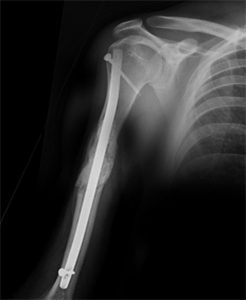
What is Prophylactic Humeral Nailing?
Benign or malignant tumors can develop in or spread to the humeral (upper arm) bone causing progressive bone tissue destruction that can lead to a fracture. Prophylactic humeral nailing is a procedure to stabilize the humeral bone that has become weak due to the presence of a tumor or cancerous lesion. The procedure involves passing a nail or rod through the intramedullary canal or central canal of the bone to reinforce the bone along its entire length. Prophylactic humeral nailing can prevent loss of function and help treat pain.
Indications for Prophylactic Humeral Nailing
Your doctor will recommend prophylactic humeral nailing after considering a number of factors including the size and type of the tumor, its location, its radiographic features, the underlying diagnosis, your level of pain and expected survival.
Diagnosis
To diagnose your condition, your symptoms and medical history are reviewed and a history and physical examination is performed. Diagnostic tests that may be ordered include X-rays, a bone scan, MRI, or CT scan. In certain cases, a biopsy of the lesion may be needed to make a clear diagnosis. If the tumor is a metastatic lesion, tests are performed to identify the primary site of the tumor.
A proper diagnosis can influence how the treatment is carried out. Some tumors are highly vascular and carry a risk of increased bleeding during surgery. Preoperative embolization (blocking off the supplying blood vessels) may be considered in such cases. Radiation may be recommended prior to surgery in other cases. Intramedullary humeral nailing may not be considered in certain types of bone tumors such as a sarcoma.
Treatment is coordinated with other specialists managing your care.
Procedure for Prophylactic Humeral Nailing
The procedure is performed under general anesthesia. You will be placed in a beach chair position. The anatomy of the humerus, humeral head, and clavicle is outlined. A skin incision is made over the greater tuberosity of the humeral head. The deltoid and supraspinatus muscles over the shoulder are split to access the bone over the shoulder. An entry hole is made above the greater tuberosity. The procedure is performed under image guidance. Instruments are used to create a path to the central or medullary canal. The length of the nail is determined. The medullary canal is reamed to receive the nail. The nail is inserted into the canal. Locking screws are placed at the upper end or lower end of the humerus to fix the nail. The overlying muscles are repaired. The tissues are closed with sutures and covered with a dressing. The arm is placed in a sling or immobilizer.
Risks of Prophylactic Humeral Nailing
As with any procedure, prophylactic humeral nailing may be associated with certain risks and complications including:
- Infection
- Blood clots
- Loss of shoulder mobility
- Pulmonary embolism
- Fat embolism (entry of bone marrow into the blood supply)
- Nerve and vessel injury
- Irritation from hardware
Benefits of the Procedure
Prophylactic humeral nailing fortifies the weakened bone with impending fracture. Stabilizing the bone in this manner also provides pain relief and is thus a palliative measure to improve quality of life.

